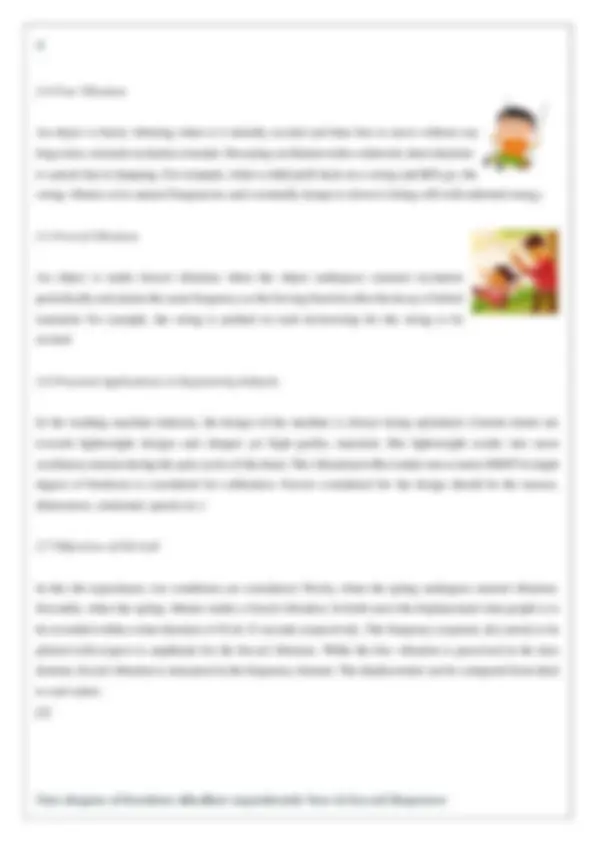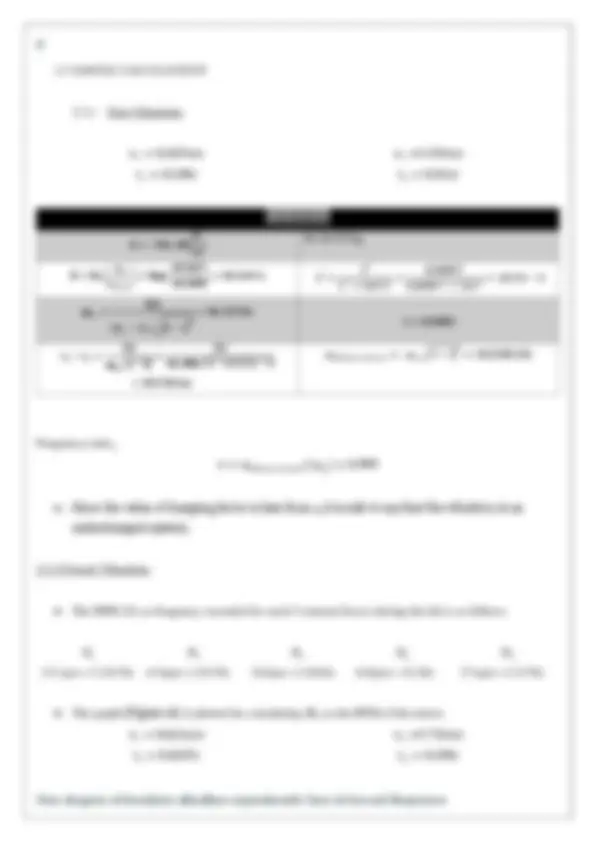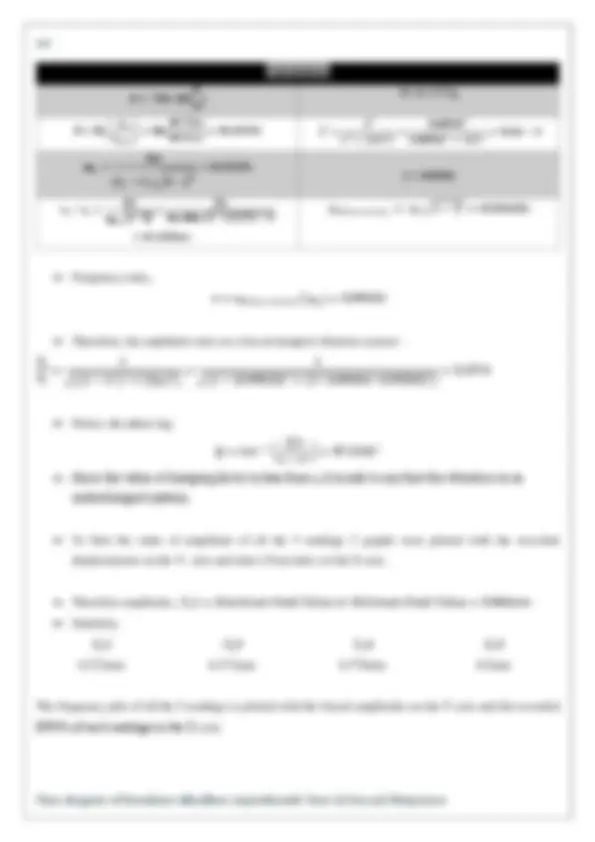











Study with the several resources on Docsity

Earn points by helping other students or get them with a premium plan


Prepare for your exams
Study with the several resources on Docsity

Earn points to download
Earn points by helping other students or get them with a premium plan
Community
Ask the community for help and clear up your study doubts
Discover the best universities in your country according to Docsity users
Free resources
Download our free guides on studying techniques, anxiety management strategies, and thesis advice from Docsity tutors
Engineering Lab Report on Vibration (Dynamics)
Typology: Lab Reports
1 / 15

This page cannot be seen from the preview
Don't miss anything!











On special offer
2.4 Free Vibration
An object is freely vibrating when it is initially excited and then free to move without any
long-term, external excitation restraint. Decaying oscillation with a relatively short duration
is caused due to damping. For example, when a child pulls back on a swing and let’s go, the
swing vibrates at its natural frequencies and eventually damps to down to being still with minimal energy.
2.5 Forced Vibration
An object is under forced vibration when the object undergoes external excitation
periodically and attains the same frequency as the forcing function after the decay of initial
transients for example, the swing is pushed on each downswing for the swing to be
excited.
2.6 Practical Applications in Engineering Industry
In the washing machine industry, the design of the machine is always being optimized. Current trends are
towards lightweight designs and cheaper yet high quality materials. But lightweight results into more
oscillatory motion during the spin cycles of the drum. The vibrational effect under one or more SDOF’s (single
degree of freedom) is considered for calibration. Factors considered for the design should be the masses,
dimensions, rotational, speeds etc.)
2.7 Objectives of this Lab
In this lab experiment, two conditions are considered. Firstly, when the spring undergoes natural vibration.
Secondly, when the spring vibrates under a forced vibration. In both cases the displacement time graph is to
be recorded within a time duration of 10 & 15 seconds respectively. The frequency response also needs to be
plotted with respect to amplitude for the forced vibration. While the free vibration is perceived in the time
domain, forced vibration is measured in the frequency domain. The displacement can be compared from ideal
to real values.
Let us consider a SHM (simple harmonic system) to help us understand the
dynamics under free and forced vibrations when at a SDOF.
∞ Newton’s 2
nd
law says: -
Net force = mass*acceleration
∑F = Ma
Or using “dot” notation or as a function of displacement
∑F = M𝑥̈ [𝑥̈ = 𝑎] [Inertial Force] ( 2 )
∞ Viscous Damping Force (F d
) is proportional to velocity: -
𝑑
= 𝑐𝑥̇ [where c is the constant of proportionality or the damper rate; units: Nsec/m]
∞ Hooke’s Law says: -
F = kx [where k is the spring constant and x is the displacement or change in length] ( 4 )
∞ Since the motion is in the vertical direction, the effect of gravity will not influence the dynamics.
∞ According to D’Alembert’s Principle: -
∑ (Inertial forces + External Forces) = 0
∞ Once we apply Newton’s 2
nd
law to this system, it can be rearranged and converted into standard form
as
∞ The undamped natural frequency of this SHM can be denoted by ω n
and can be calculated as:
ω
𝑛
𝑘
𝑀
[where m is mass and k is stiffness]
Figure 1 FBD of Free Damped Vibration
∞ Now, to get the solution we must assume a harmonic solution that 𝑥 = 𝐴𝑒
𝑠𝑡
[A is a complex
coefficient, 𝑠 = 𝑖𝜔, 𝑎𝑛𝑑 𝜔 𝑖𝑠 𝑡ℎ𝑒 𝑓𝑟𝑒𝑞𝑢𝑒𝑛𝑐𝑦 𝑖𝑛 (
𝑟𝑎𝑑
𝑠
∞ Hence due to the first-time derivative of the displacement, 𝑥̇ = 𝑠𝐴𝑒
𝑠𝑡
2
𝑠𝑡
∞ The equations for displacement in for the following 3 conditions are obtained after plugging in (12,
13, 14) in (9) and further differentiating, finding roots of unknown values and simplifying: -
Overdamped ( 𝜁 > 1 ) Critical Damped ( 𝜁 = 1 ) Underdamped ( 𝜁 < 1 )
𝑥 = 𝐴𝑒
(−𝜁+√− 1 +𝜁
2
)ω 𝑛
𝑡
(−𝜁−√− 1 +𝜁
2
)ω 𝑛
𝑡
𝑥 =
( 𝐴 + 𝐵𝑡
) 𝑒
−𝜁ω
𝑛
𝑡
=
( 𝐴 + 𝐵𝑡
) 𝑒
ω
𝑛
𝑡
0
𝑒
−𝜁ω
𝑛
𝑡
sin(ω
𝑛
2
𝑡 + ɸ)
∞ When the system is underdamped from Figure 1, the damping factor will have a maximum value of 1
at any peak of the sin wave. Therefore,
1
0
−𝜁ω 𝑛
𝑡 1
(1 5 )
2
0
−𝜁ω
𝑛
𝑡
2
(16)
∞ As we take the ratio of x 1
and x 2
we get
x 1
x 2
𝑥
0
𝑒
−𝜁ω
𝑛
𝑡
1
𝑥
0
𝑒
−𝜁ω 𝑛
𝑡 2
𝜁ω
𝑛
(𝑡
2
−𝑡
1
)
∞ As per Figure 1, the time required for 1 cycle of vibration to occur is at a damped frequency (ω
𝑑
∞ Time required is 𝑡
2
1
. Hence, 𝑡
2
1
= ω
𝑑
= ω
𝑛
√ 1 − ζ
2
∞ In SI units, time required
2
1
ω
𝑛
√ 1 − ζ
2
∞ Therefore, for an undamped system, if its N cycles to separate the logarithmic decrement
δ = log (
𝑥
1
𝑥
𝑛+ 1
2 𝜋ζ𝑁
√ 1 −ζ
2
and hence ζ
2
𝛿
2
𝛿
2
+( 2 𝜋𝑁)
2
3.2 External Sources for Forced Damped Vibration
∞ While the free vibration is perceived in the time domain, forced vibration is
measured in the frequency domain. This emphasizes the magnitude and phase
dependence on frequency and enables the convenient identification of natural
frequencies.
Figure 3 FBD of
Forced Vibration
∞ A typical source of forced vibration in mechanical systems is rotating imbalance. In forced vibration,
large vibrations occur when the forcing frequency, ω, is near a system natural frequency, ω
𝑛
∞ The external force exciting a forced vibration is assumed to be sinusoidal. Considering a sinusoidal or
a harmonic excitation or force acting in the positive direction on the system, any external excitation
force can be thought of as a sum of sinusoidal forces. Hence the force F on the mass m is
0
sin 𝜔𝑡 (20)
Hence the displacement position is 𝑥 = 𝑋
0
sin(𝜔𝑡 − ɸ) [where 𝑋
0
is the amplitude of
the response sine wave and ɸ is the measure of the delay between F and 𝐹
0
∞ The displacement can be differentiated to derive velocity and acceleration.
0
cos(𝜔𝑡 − ɸ) ( 22 )
2
0
sin(𝜔𝑡 − ɸ) (23)
According to D’Alembert’s principle; 𝑥̈ +
𝑐
𝑀
𝑘
𝑀
0
sin 𝜔𝑡
∞ All factors in the above equation can be represented onto a Y-axis of a cartesian
co-ordinate system [Figure 4 ].
∞ With the help of Pythagoras theorem, we can learn that
0
2
2
2
0
and ɸ = 𝑡𝑎𝑛
− 1
𝑐𝜔
𝑘−𝑚𝜔
2
∞ As we keep the excited force constant, we can measure the change in amplitude
of the mass. Hence rearranging the previous equation;
𝑋
0
𝐹
0
1
√(𝑘−𝑀𝜔
2
)
2
+(𝑐𝜔)
2
)
∞ After the decay of initial transition, a static deflection will exist due to the forced vibration.
𝑜
𝑘
𝐹 0
and 𝑛 =
𝜔
𝜔 𝑛
[n is the frequency ratio and n
𝑝𝑒𝑎𝑘
= √ 1 − 2 ζ
2
∞ With the help of equation of (6), (8) and (23); the change in amplitude can be found as:
0
0
2
2
2
∞ And the phase lag;
− 1
2 𝜁𝑛
1 −𝑛
2
The application of the above equations is plugged into sample calculations below.
Figure 4 Vector graph
of factors on Forced
Vibration
Calculations
𝒌 = 𝟕𝟐𝟓. 𝟑𝟑[
𝑵
𝒎
]
M =0.557kg
𝛅 = 𝐥n (
𝒙
𝟏
𝒙
𝒏+𝟏
) = 𝐥𝐧 (
𝟎. 756
𝟎. 411
) = 𝟎. 60944 ζ
2
=
𝛿
2
𝛿
2
2
=
2
2
( 2 𝜋
)
2
= 9. 32 𝑒 − 3
𝛚
𝒏
=
𝟐
𝟏
√
𝟏 − 𝜻
𝟐
= 44. 052 𝑯𝒛
ζ = 0. 09654
𝒕
𝟐
− 𝒕
𝟏
=
𝟐𝝅
𝛚
𝒏
√𝟏 − 𝛇
𝟐
=
𝟐𝝅
𝟑𝟔. 𝟎𝟖𝟔 √
𝟏 − 𝟏. 517 𝒆 − 3
= 𝟎. 1433 𝒔𝒆𝒄
ω
𝑑𝑡ℎ𝑒𝑜𝑟𝑒𝑡𝑖𝑐𝑎𝑙
= ω
𝑛
√ 1 − ζ
2
∞ Frequency ratio,
𝑛 = ω
𝑑𝑡ℎ𝑒𝑜𝑟𝑒𝑡𝑖𝑐𝑎𝑙
/(ω
𝑛
∞ Therefore, the amplitude ratio on a forced damped vibration system: -
0
0
2
2
2 ζ𝜔
2
2
2
∞ Hence, the phase lag,
− 1
2
𝑜
∞ Since the value of damping factor is less than 1, it is safe to say that the vibration is an
underdamped system.
∞ To find the value of amplitude of all the 5 readings 5 graphs were plotted with the recorded
displacements on the Y- axis and time (15seconds) on the X-axis.
∞ Therefore amplitude 1
0
∞ Similarly,
0
0
0
0
The frequency plot of all the 5 readings is plotted with the forced amplitudes on the Y-axis and the recorded
RPM’s of each readings on the X-axis.
4 Equipment
Figure 5
Figure 6
Figure 7
Figure 8
Figure 9
Accelerometer(pote
ntiometer) to
analogically
increase the speed
of the eccentric
rotor wheel.
to measure the
RPM on the
eccentric rotor
mass career of the mass
spring module held with
a nut & bolt system.
wheel
Type Viscous
Damper (Viscous
medium is water).
Figure 10
Figure 11 Figure 12
Figure 13
6.Wireless
Sensors to collect
data in the
framework of a
wireless data
acquisition
system.
Damper Module
vibration test
Vibration fundamentals
Training System.
manufacture and few
technical details.
custom built VFT
software to
perform wide
gamut of
vibration
experiments.
∞ Displacement, force, acceleration is measured to describe vibration and mechanics of structures, the device is
useful for learning how to use different types of transducers and associated signal conditioning issues.
Applications of tachometers etc. in studies of vibration phenomena can be investigated. Data acquisition and
importance of signal processing in proper analysis can be emphasized.[5]
Figure 14
Figure 15 Free Vibration Graph Figure 16 Forced Vibration Graph
Figure 17 Frequency Plot
6.1 Free Vibration
The spring-mass system when faced with a base excitation, retracts to equilibrium eventually due to damped
force or through the transient moment will decay as time passes. Such a freely damped system can have
transient solutions for a fairly stretched amount of time as the vibration has not reduced from 2secs till 10
seconds in [Figure 15]. The displacement of the wave is proportional to the initial force applied to the system.
Frequency of the free vibration changes with respect to the mass and spring coefficient. As we can see there
is hardly a difference between the natural and the damped frequency as the system is underdamped (the
damping factor was close to 0). The frequencies both, natural and damped, when equal to each other would
create resonance which could impact the spring and further create more vibrations causing the nuts and bolts
to get loose.
-0.
-0.
-0.
0
0 1 2 3 4 5 6 7 8 9 10
Displacement
Time(s)
F R E E D A M P E D V I B R A T I O N S D O F
-0.
-0.
-0.
-0.
0
1
0 1 2 3 4 5 6 7 8 9 10 11 12 13 14 15
Displacement
Time(s)
F O R C E D D A M P E D V I B R A T I O N S D O F
0
1
0 5 10 15
Amplitude(mm)
Frequency(Hz)
F R E Q U E N C Y P L O T
6.2 Forced Vibration
The system is an underdamped sinusoidal wave as the damping factor is less than zero. The viscous fluid is
water. From the graph, we can see that due to the sinusoidal movement of the wave, each frequency response
reaches its peak a short time after the forces reaches a peak. The phase angle was calculated to be
approximately 90 deg (exactly 87. 2241
𝑜
) out of phase with a displacement and has the opposite sign from
velocity. So, the delay between the force reaching the peak and the response reaching its peak is almost 90
deg. The viscous damping force is inversely proportional to velocity. The frequencies both, natural and
damped, when equal would create resonance which could impact the spring and further create more vibrations
causing the nuts and bolts to get loose. [Figure 16]
6.3 Frequency Plot
Due to the eccentricity of the rotor, the amplitude is maximum when the speed of the rotor is not too fast
allowing the uneven diameter of the rotor to apply more pressure on the spring. Whereas, when the speed
increases, the rotor spins even quickly such that time allows the damping factor to increase which decreases
the amplitude of the wave. The eccentric nature of the rotor makes the amplitude and frequency plot to be
linear and parabolic, but the consistency of the data sets allows the wave to have a harmonic pattern.
Experience has shown that 10 to 15 iterations are generally adequate to study the trendline of the wave.
[Figure 17 ]
6.4 Risk & Recommendations : -
∞ Risk Assessment form is to be understood and signed by all members of the group before any
professional lab experiment.
∞ Since the tachometer reading is done as the instrument is freely held by hand, there can be an error of
200 – 300 units of RPM to increase or decrease.
∞ The accelerometer reading is manually adjusted and there is no way to automatically set a desired
RPM for the rotor. So, it would be recommended to get a metered accelerometer as an advancement.
∞ As the values of both the natural and the damped frequencies get very close to each other, the vibration
reaches a state of resonance which would affect the grip of the screws resulting it to become loose and
wobbly.
∞ The atmosphere should be calm as the vibrations from our voices could be picked up by the sensors
which can influence the results.